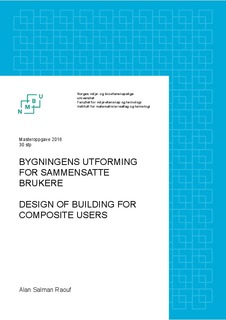| dc.contributor.advisor | Houck, Leif Daniel | |
| dc.contributor.author | Raouf, Alan Salman | |
| dc.date.accessioned | 2017-01-02T15:15:15Z | |
| dc.date.available | 2017-01-02T15:15:15Z | |
| dc.date.issued | 2017-01-02 | |
| dc.identifier.uri | http://hdl.handle.net/11250/2426039 | |
| dc.description.abstract | I denne masteroppgaven ser jeg på hvordan man kan utforme et boligbygg som skal samlokalisere boliger for ulike grupper av vanskeligstilte. Dette skal gjøres gjennom å utnytte tomtepotensialet i en eksisterende kommunal boligblokk i bydel Bjerke i Oslo. Dette med tanke på utfordringen som knyttes til bomiljø som følge av sammensetting av ulike målgrupper, og Husbankens forutsetninger for de økonomiske tilskuddsordninger det gis for oppføring av nye boliger for vanskeligstilte.
Resultatet viser at det bør være mulig å utforme et bygg på den valgte tomten, der hensynet til samlokalisering av ulike målgrupper tas inn i planleggingen – med de kvaliteter som gjør utfordringer knyttet til bomiljø håndterbar – samtidig som bokvaliteten til de menneskene som får tilbud om å bo i bygningen overholdes. Sistnevnte forutsetter en aktiv deltagelse og et godt planlagt bomiljøarbeid fra bydelen.
Det eksisterende bygget har ca. 100 mindre boenheter, i tillegg til felleslokaler og kontorer som bydelen disponerer. Det utformede bygget har 70 boenheter i ulik størrelse, som passer til mennesker i ulike livsfaser, og felleslokaler som kan driftes med den hensikt å skape bedre trivsel og bomiljø i nærområdet. Det at antall boenheter reduseres fra 100 til 70, samtidig som man overholder et forsvarlig botilbud i bydelen, med en god utnyttelse av tomten og et variert botilbud, er å regne som god og bærekraftig håndtering av planområdet. Redusering av antall boenheter fra nåværende nivå vil påvirke bomiljøet og institusjonspreget det eksisterende bygget har, og vil bidra til å skape et mer ”ordinært” og balansert bomiljø med urban bokvalitet. Dersom et vis antall leiligheter leies ut i det privatmarkedet vil dette kunne ha positiv innvirkning på bomiljøet.
Bebyggelsesstrukturen i området består av høye boligblokker med opptil 12 etasjer som dominerer området. Dette tilsier at nye bygninger bør tilpasses området når det gjelder form og størrelse. Dersom antall boliger reduseres i den grad at det påvirker høyden og formen til det nye bygget, kan det resultere i en bygningsform som vil skille seg ut i forhold til den eksisterende bebyggelsen og dermed forsterke stigmatiseringseffekten en kommunal boligblokk får, noe Husbanken fraråder | nb_NO |
| dc.description.abstract | In this thesis, I will look at how to design a building society to collocate housing for different groups of disadvantaged in the housing market. This will be achieved by utilizing the site potential of an existing municipal building in District Bjerke in Oslo. An important part of the thesis is to consider the challenge in living environments as a result of different groups of tenants, and the terms given from the Norwegian State Housing Bank for the financial subsidy, which is granted for developing new houses for this purpose. The result shows that it is? possible to design a building on the selected site, which takes into consideration the collocation of various target groups– and makes the challenges related to the living environment manageable – while maintaining good living conditions for the tenants. This requires active participation and a well-planned living environment from the district authorities. The existing building has approximately 100 smaller living units, in addition to common areas and offices used by the district authorities. The designed building has 70 living units in different sizes, suitable for people in different life stages, together with public facilities to improve the living environment in the surrounding area. The fact that the number of living units is reduced from 100 to 70, while maintaining a sufficient housing offer in the district, with good utilization of the site with varied living units, is regarded as good and sustainable management of the district planning area. The reduction of the number of living units will affect the living environment and reduce the institution-like characteristics of the existing building, and will help to create a more "ordinary" and balanced living environment with urban living qualities. If in addition a number of apartments were rented out in the private market, this could have a positive impact on the living environment. Surrounding buildings that dominate the area consists of high rises with up to 12 levels. This means that new buildings should be adapted to the area in terms of shape and size. If the number of living units are reduced to the extent that it affects the height and shape of the new building, it could result in a building shape that will stand out in relation to the existing buildings and thus reinforce the stigma effect a social housing building gets, which the Norwegian State Housing Bank discourages | nb_NO |
| dc.language.iso | nob | nb_NO |
| dc.publisher | Norwegian University of Life Sciences, Ås | |
| dc.subject | utforming av bygg | nb_NO |
| dc.subject | sammensatte brukere | nb_NO |
| dc.subject | vanskeligstilte på boligmarkedet | nb_NO |
| dc.subject | målgrupper | nb_NO |
| dc.subject | boligsosialt arbeid | nb_NO |
| dc.title | Bygningens utforming for sammensatte brukere | nb_NO |
| dc.title.alternative | Design of building for composite users | nb_NO |
| dc.type | Master thesis | nb_NO |
| dc.subject.nsi | VDP::Technology: 500::Building technology: 530 | nb_NO |
| dc.subject.nsi | VDP::Technology: 500 | nb_NO |
| dc.source.pagenumber | 100 | nb_NO |
| dc.description.localcode | M-BA | nb_NO |
